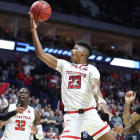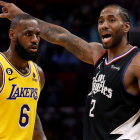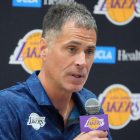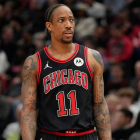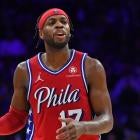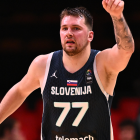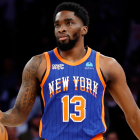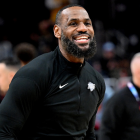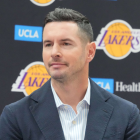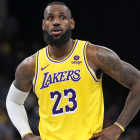CHICAGO -- It's hard to defend and guard Duke's Zion Williamson. That elusiveness came in handy during NBA Draft Combine.
After showing up for lottery night to watch the Pelicans win the draft lottery, Williamson was reportedly whisked away from the scene, his full reaction to the madness disappearing into the shadows. Williamson then fulfilled his NBA-assigned meetings with teams the following day and left town, choosing not to go through in workouts, scrimmages or measurements at the combine.
Williamson wasn't the only player to pull a disappearing act like Criss Angel in the Windy City. And let's face it: for him, there are zero ramifications for such a move. Whether he attended the combine or a Cubs game, he's still expected to be the first prospect called by name on draft night next month by NBA Commissioner Adam Silver. Most players have a draft range -- a section of selections where they are projected to be taken by an NBA team -- but Williamson's is just a number: No. 1. Playing in scrimmages would have been interesting (and a circus with most league executives in town to watch), but ultimately it would have been silly. He had nothing to gain and much more to lose.
Not every player has a single number draft range, though. Ja Morant is likely to be drafted between the No. 2 and No. 4 picks, for instance. RJ Barrett is also likely to fall between No. 2 and No. 4, just like Morant. But the rest of the field figures to be largely up for grabs. Some enigmatic prospects could be drafted between No. 5 and No. 25, others between No. 11 and No. 20. Opinions vary on different prospects dependent upon projected value and upside.
After workouts, scrimmages, agility drills and interviews this past week at the combine, the order seems to be shifting like soil atop a fault line. After scouting the 60-plus players firsthand in Chicago, we've formulated an up-to-date first-round mock draft with the latest evaluations.
Kyle Boone's latest NBA Mock Draft
| 1 | |
Zion Williamson | Duke | Fr | PF | 6-7 Williamson is one of the most highly-touted prospects of the one-and-done era, perhaps second only to Anthony Davis -- who he'd be paired with in New Orleans. Williamson's an incredible athlete who packs power and force in his game, and he channeled it to put up 22.6 points, 8.9 rebounds and 2.1 steals per game at Duke. Alongside Davis, the Pelicans could have a dynamo frontcourt that would be among the most talented and exciting in the league next season. David Griffin, the Pelicans' executive VP of basketball operations has the draft's easiest decision. | |
| 2 | |
Ja Morant | Murray St. | Soph | PG | 6-3 Memphis' rebuilding effort has officially been expedited. After moving up the lottery and securing the No. 2 pick, they've lucked out by being in position to draft Mike Conley's successor at point guard in Morant. Morant is the best and most creative passer in this draft -- one-handed lasers, no-look zips, he's got it all in his package. Morant led the NCAA last season with a 51.9% assist rate, and he's the first player to average at least 10 assists per game since Nelson Haggerty in 1994. | |
| 3 | |
RJ Barrett | Duke | Fr | SF | 6-7 Probably not the Duke star Knicks had in mind on lottery night, but Barrett is more than just a consolation -- he's a building block. Barrett is an instinctive scorer who averaged 22.6 points per game at Duke -- tied for the most on Duke's roster with Zion Williamson -- and he's got good playmaking skills to boot. Barrett at Duke was sometimes criticized for being an efficient scorer who dominated the ball, which are valid concerns. Still yet, there's reason to believe in Barrett because of his instincts and pure competitiveness. If we look up in five years and he's the best player in this draft class, it wouldn't be the most stunning development. | |
| 4 | |
De'Andre Hunter | Virginia | Jr | SF | 6-7 If the Lakers want an immediate impact player -- and based on LeBron James's championship window, most suspect they do -- Hunter fits the bill. After redshirting his first season, Hunter put together consecutive seasons in which he shot greater than 38% from 3-point range -- including 43.8% last season. To complement his deep threat ability, Hunter is a tenacious defender who can switch onto guards, a premium trait for forwards in the NBA. | |
| 5 | |
Jarrett Culver | Texas Tech | Soph | SG | 6-6 Culver is a terrific all-around player who does a lot of things really well. He can defend at a high level, he can knock down open jumpers, he can handle the ball competently. The concern for Culver is that he's good at a variety of things but perhaps not great at one single thing. But he's just 20-years-old and still maturing physically, and last season he was cast in a role he'll likely never serve again as a No. 1 option. In the right system with the right surroundings, he can be an excellent 3-and-D role player. | |
| 6 | |
Darius Garland | Vanderbilt | Fr | PG | 6-2 The Suns employed more point guards last season than most franchises do in two seasons. At No. 6, they'll have a shot to draft a player at the position they can build around and do by taking Garland. Garland played just five games at Vanderbilt last season as a freshman, but he was stellar before a season ending injury: 16.2 points, 3.8 rebounds, 2.6 assists per game while shooting 58.1% from the floor and 47.8% from 3-point range. Garland's ball-handling is among the best in this draft class, despite a negative assist-turnover ratio. And his scoring ability could perfectly complement Phoenix's young core -- namely backcourt buddy-to-be Devin Booker. | |
| 7 | |
Coby White | North Carolina | Fr | PG | 6-5 White is seen as a score-first point guard, but he is absolutely capable of creating and facilitating because of his top-end speed and elusiveness. If Chicago wants someone to solidify a position in need of an upgrade for the long-term, White can fill that void. At North Carolina he averaged 16.1 points and 4.1 assists per game while shooting 35.3% from 3-point range. Perhaps the most telling number, though, is 30.7: the percentage of points he scored in transition. He loves to push the pace and plays with poise. Decision-making and the ins-and-outs of playing as a primary creator is still where he most needs development, but in time he can be a tremendous piece for the Bulls to build with and around. | |
| 8 | |
Cameron Reddish | Duke | SG | 6-8 Reddish has a blue-chip background but a confounding résumé, having largely underwhelmed at Duke last season. Was it the situation alongside Zion Williamson and RJ Barrett, two stars who commanded most touches? Or was it a red flag that Reddish simply could not put it all together? His inability to stand out does cause concern. But with a 6-foot-8 frame, a beautiful shot release and defensive capabilities that should translate immediately, Hawks GM Travis Schlenk should bite on the upside. Paired with Trae Young and Kevin Huerter, Schlenk has to be thrilled about the prospects of adding Reddish to an already promising young backcourt brimming with talent. | |
| 9 | |
Bol Bol | Oregon | Fr | C | 7-2 Why is Bol Bol, a 7-2 center who averaged 21 points, 9.6 rebounds, 2.7 blocks and shot 57% from 3-point range, so hard to peg? Because he played just nine games before sustaining a season-ending foot injury. Injuries are always a concern, but especially for 7-footers. But Bol's talent is going to leave teams with a tough choice: bet on a healthy version, or play it safe? Washington's in position to go swing big. With John Wall out for the foreseeable future, the Wizards desperately need not squander Bradley Beal's prime. If Bol can stay healthy, a Beal-Bol pairing would be sublime. | |
| 10 | |
Jaxson Hayes | Texas | Fr | PF | 6-11 With John Collins in place, some could fear duplicative talents. But Hayes is likely better suited at center, which would allow Collins to play at power forward. The match here would be *chef's kiss* magnificent. Hayes is a preternatural shot-blocker with instincts well beyond his years. He's still very raw; his first start as a basketball player came as a senior in high school, in large part due to a growth spurt from 6-foot to 6-11 from high school freshman to college freshman. But the springy nature of his game and potential as a rim-running, shot-swatting specialist makes a ton of sense for the Hawks. | |
| 11 | |
Brandon Clarke | Gonzaga | Jr | PF | 6-8 Clarke's 6-8.25 wingspan and 8-6 standing reach came in smaller than a number of guards and forwards at the NBA Draft Combine. That's not great news for an aspiring NBA power forward. But there's hope: he had a max vertical leap of 40.5 inches, which ranked No. 1 among players at his position. He also finished No. 1 in lane agility and No. 2 in standing vertical leap. Can he be the same physically imposing big man in the NBA, the one who led the NCAA last season in shots blocked and field goal percentage, with such a vast array of measurements and skills? If he can, Minnesota's a great fit. He could hide a lot of Karl-Anthony Towns' defensive weaknesses with his shot-blocking and ability to cover space. And for a franchise that's all-in on surrounding KAT with pieces to be successful, isn't that perhaps Clarke's best qualification? | |
| 12 | |
Sekou Doumbouya | France | SF | 6-9 Doumbouya is a do-it-all forward who is coming on strong as draft season heats up. He scored a career-high 34 points and grabbed nine rebounds for Limoges CSP last week, just a week before the French playoffs, and seems to have fully rebounded from a right hand injury at the end of 2018. Doumbouya's raw but promising, a forward who for his size has great ball-handling skills and figures to be a plus defender in the NBA. He'll need development and a team devoted to helping his realize his potential, and Charlotte's a great spot where he could play quality minutes and grow into the versatile forward who can space the floor the NBA now places so much value in. | |
| 13 | |
Romeo Langford | Indiana | Fr | SG | 6-6 Langford is a rangy wing prospect who last season at Indiana saw his stock dip a tad. In large part, his stock dropped not because of his numbers -- he averaged 16.5 points and 5.4 rebounds per game -- but because of his inefficient scoring. (49% from the field, 27.2% from 3-point range.) A torn ligament in his shooting hand likely had a lot to do with that. If he can become more effective, Miami could get a former top-10 recruit and a formerly pegged top-10 prospect at a discount rate here at No. 13. With Dwyane Wade retiring, he gives the Heat a player to fill rotation minutes at the position immediately and a player with starpower to build around as time wears on. | |
| 14 | |
PJ Washington | Kentucky | Soph | PF | 6-8 Marcus Morris is set to become an unrestricted free agent, which means Boston should think about addressing the power forward position with one of its many picks. So Washington fits an obvious need if Morris doesn't re-sign. While he's not the same type of player Morris is, he's an excellent 3-point shooter with length to be a multi-positional defender. At Kentucky last season he averaged 15.2 points and 7.5 rebounds per game while shooting a team-leading 42.3% from 3-point range. Washington is an an idyllic, modern-day stretch forward. | |
| 15 | |
Kevin Porter Jr. | USC | Fr | SG | 6-6 Questions surround Porter Jr. after he was suspended last season at Southern Cal for conduct issues, but he's so talented it's unlikely he falls far past the lottery (if he's not snatched up inside the lottery). A great creator with the ball in his hands, Porter Jr. has drawn comparisons to James Harden in part because of his left-handed release and also because of his ability to create separation to manufacture his own shot. Detroit needs shot-creators and secondary ball-handlers, and Porter Jr. could address both of those needs. | |
| 16 | |
Nassir Little | North Carolina | Fr | SF | 6-6 While Little underwhelmed last season at North Carolina, scoring only 9.8 points and grabbing 4.6 boards per game, context is important to consider. He played on a team that was upperclassmen-laden at his position, and couldn't quite pick things up fast enough to become a centerpiece as a freshman. But Little's an athletic freak, a former McDonald's All-American Game MVP, and a rangy forward. His size and length will be appealing to teams picking in the teens, especially for a Magic franchise that would love to buy low on a prospect of his caliber. | |
| 17 | |
Rui Hachimura | Gonzaga | Jr | PF | 6-8 DeMarre Carroll is headed towards unrestricted free agency and Jared Dudley turns 34 this summer. The Nets could have some gaps to fill at forward. Hachimura fills a need having played both forward positions at Gonzaga, versatility the Nets should find alluring. For such a large frame, Hachimura can fill such a wide range of roles. From attacking off the dribble to shooting 3-pointers to versatility as a defender, Brooklyn could certainly find value in what he brings. | |
| 18 | |
Tyler Herro | Kentucky | Fr | SG | 6-5 As the Pacers continue to add pieces to surround Victor Oladipo with talent, Herro should be a name they'll consider. An excellent scorer and shooter, Herro could alleviate some playmaking pressure off Oladipo, too, as he's capable of creating shots for himself off the dribble and an underrated passer. Wesley Matthews's imminent unrestricted free agency and Tyreke Evans's recent disqualification from the NBA makes this an all-the-more savvy selection at No. 18. | |
| 19 | |
Keldon Johnson | Kentucky | Fr | SG | 6-6 Johnson is a competitive, tough-minded forward prospect who can knock down 3-pointers and defend the perimeter at a high level. Gregg Popovich will love his aggressive spirit, and fans in San Antonio will love his high-flying dunks and athletic gifts that come with the package. As Rudy Gay hits unrestricted free agency and Marco Belinelli readies to follow in 2020, Johnson could not only be a talent grab but also fill a need. | |
| 20 | |
Pick acquired via trade with Los Angeles Clippers Goga Bitadze | Mega Bemax | C | 6-11 Bitadze remains an unknown to many having played overseas, most recently for Mega Bemax in Serbia, but he's one of the best center prospects in this draft class. Bitadze is a creative big man who is terrific in the midrange, crafty with the ball in his hands, and a strong force in the post. His offensive upside as a big man will be a huge draw for teams. Boston could look to draft and develop him with Al Horford as a long-term successor -- or as a short-term sidekick. | |
| 21 | |
Cameron Johnson | North Carolina | SF | 6-9 Johnson is one of the best, if not the best, shooters in this draft class. And guess what Oklahoma City could use? You guessed it: Shooting. Pairing Johnson, who shot 45.7% from the floor last season at UNC, along with Russell Westbrook and Paul George would be a smart move for GM Sam Presti. | |
| 22 | |
Talen Horton-Tucker | Iowa St. | Fr | SF | 6-4 Days before the NBA Draft Combine, Horton-Tucker it was reported that he was alleged to have shoplifted $15.93 worth of goods from Walmart, a topic he was asked about frequently in Chicago, raising an unwelcome red flag teams must consider. On the court, he's an intriguing guard/forward whose wingspan measured out longer than many power forwards. Danny Ainge places a lot of stock in versatility and length, particularly at forward. | |
| 23 | |
Nickeil Alexander-Walker | Virginia Tech | Soph | SG | 6-6 Utah seems determined to add a point guard with Ricky Rubio entering unrestricted free agency and Dante Exum simply not performing at a high enough level to earn big minutes for a playoff team. Alexander-Walker is a best of both worlds player in that regard; at Virginia Tech he played both point guard and shooting guard, and showed he's a capable distributor, creator and transition player. He could complement Mitchell well in particular with floor-spacing; his 37.4% accuracy from 3-point range last season would require defenders' attention. | |
| 24 | |
Dylan Windler | Belmont | Sr | SG | 6-8 Philly likely won't be able to retain its entire core of Jimmy Butler, JJ Redick and Tobias Harris. So a tough decision is coming: Where can it afford to go cheap on? If Redick ends up being the odd man out, Windler makes sense as a late-first addition with his ability to make contested shots and consistency as a 3-point threat. At Belmont his last three seasons he shot 42.9, 42.6 and 39.8% from 3-point range, improving each of his four seasons as a scorer. | |
| 25 | |
Grant Williams | Tennessee | Jr | PF | 6-7 Portland's roster as currently constructed is Western Conference Finals good, but with a tweak or two, can it be NBA Finals good? Adding the No. 25 pick alone isn't likely enough -- but it's a solid start if Williams is on the board. He's a tough, physically imposing forward who won consecutive SEC Player of the Year honors in his final two seasons. He can play power forward or, potentially, center in small-ball lineups. Think a slightly taller, slightly heavier PJ Tucker with a splash of playmaking. | |
| 26 | |
Pick acquired via trade with Houston Luka Samanic | Olimpija Ljubljana | PF | 6-11 Samanic was the clear-cut winner from the combine. He played so well on the first day he shut it down on the second day, as buzz about him improving his stock into the first round filled the gym in Chicago. He was the best player from Day One of the combine, showing off some impressive handles, a smooth shot, and range from 3-point range that is a rarity for 6-11 bigs. | |
| 27 | |
Pick acquired via trade with Denver Carsen Edwards | Purdue | Jr | PG | 6-0 Edwards improved his stock dramatically with a mystical NCAA Tournament appearance in which he scored 139 combined points in four games, including two 42-point outbursts. His performance was a showcase of what he can be in the NBA: a microwave scorer who can handle the ball and make shots from Mars. | |
| 28 | |
Luguentz Dort | Arizona State | Fr | SG | 6-4 No team could ever prepare for a nightmare scenario like the possibility of Kevin Durant leaving in free agency. So Golden State should approach this pick by simply taking best player on the board in Luguentz Dort, a tough and tenacious defender who can become a quality role player even on a star-studded roster like Golden State's. | |
| 29 | |
Pick acquired via trade with Toronto Mfiondu Kabengele | Florida State | Soph | PF | 6-10 The Spurs have LaMarcus Aldrige locked in under contract through 2020-2021, but this is a pick with an eye on that date. Kabengele is an impressive floor-spacing big man who last season at Florida State averaged 13.2 points and 5.9 rebounds while making 36.9% of his 3-pointers. (As a freshman he made 38.5%). He's still growing into what he'll ultimately become but his stock is on the rise as he continues to get better each year. | |
| 30 | |
Daniel Gafford | Arkansas | Soph | C | 6-11 What do you get a team with a 6-11 athletic freak in Giannis? How about another 6-11 athletic freak? Gafford's talents are vastly different than that of Antetokounmpo's, but nonetheless important. He can be an early impact rim-protector and roll-man in a Bucks ecosystem that could allow him to flourish. | |

































